Yachting World
- Digital Edition


First look: Arcona 415 – electric production yacht
- Rupert Holmes
- November 29, 2021
The Arcona 415 comes with electric propulsion as standard, continuing the brand's move towards more eco-friendly production yachts

The new Arcona 415 is pitched as the first series-produced yacht with electric propulsion as standard.
Arcona already has a long history of developing boats with optional electric motors, dating back to the 380Z (for Zero emissions), which was launched in 2015. As well as the electric motor, this boat was fitted with a large array of solar panels, including some that were laminated into the cloth of the mainsail.
Since then, much has changed to make such a yacht more practical. The cost of solar panels is continuing to fall, for instance, and there are now more options for regeneration of electricity using the propeller when sailing.
However, arguably the biggest and most important advances have been in lithium-ion batteries . These are gaining 20% more power each year, while remaining the same physical size and cost. Today you can therefore buy a battery pack with double the power of one four years ago, for the same money.
As with other designs from the Arcona yard, the 415 is a powerful performance cruiser. It’s based on the existing 10-year-old Arcona 410 , with updates and modifications including a more open transom and larger windows, both in the coachroof and hull.
The standard motor is a 15kW Oceanvolt unit that gives equivalent thrust to a 50hp diesel. A 19kW bank of lithium-ion batteries is fitted as standard. There’s also a service bank of two 90Ah AGM batteries. “Electric is here to stay,” says Arcona’s CEO Urban Lagnéus. “Our performance cruisers will always sail beautifully, but in light winds, when you need to use the engine, electric propulsion is the way forward.”
Arcona 415 specifications
LOA: 12.2m / 40ft 0in Beam: 3.9m / 12ft 10in Draught: 2.0, 2.2 or 2.5m / 6ft 7in, 7ft 3in or 8ft 2in Displacement: 7,800kg / 17,200lb Price: €345,347 ex VAT Builder: arconayachts.se
If you enjoyed this….
Yachting World is the world’s leading magazine for bluewater cruisers and offshore sailors. Every month we have inspirational adventures and practical features to help you realise your sailing dreams. Build your knowledge with a subscription delivered to your door. See our latest offers and save at least 30% off the cover price.
- BOAT OF THE YEAR
- Newsletters
- Sailboat Reviews
- Boating Safety
- Sails and Rigging
- Maintenance
- Sailing Totem
- Sailor & Galley
- Living Aboard
- Destinations
- Gear & Electronics
- Charter Resources
- Ultimate Boating Giveaway

The Promises and Pitfalls of an All-Electric Yacht
- By Tim Murphy
- Updated: November 8, 2021
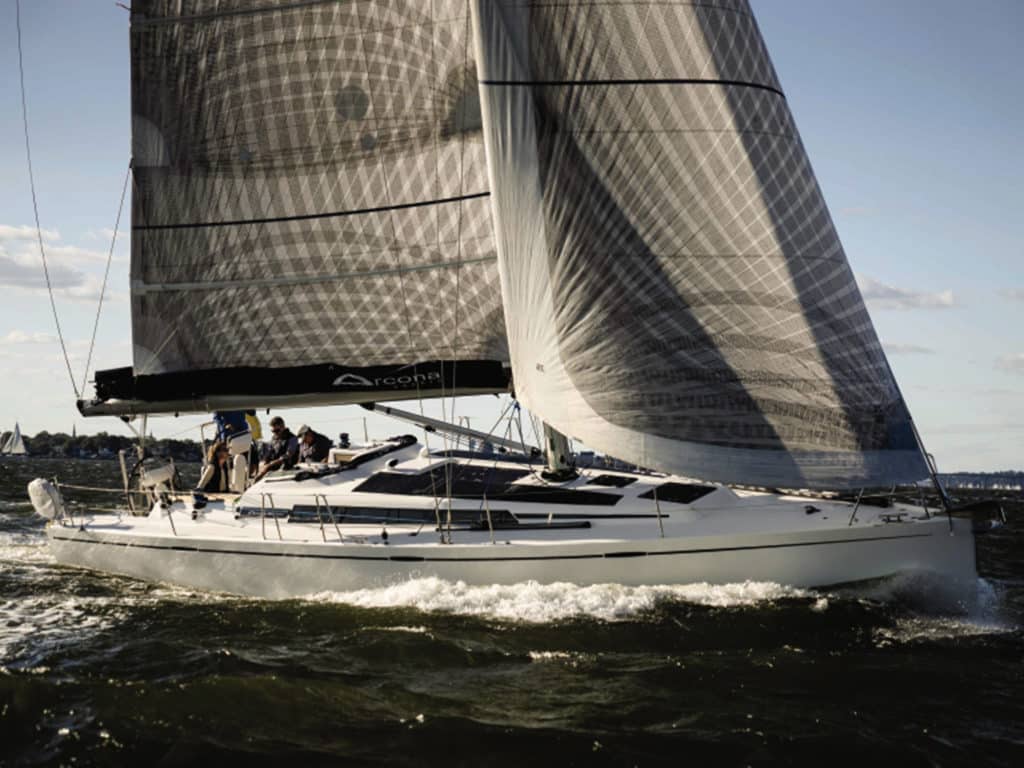
This past October, I saw one of the most interesting exhibits in more than 500 new cruising sailboats I’ve reviewed over two decades. It was the Arcona 435Z, built in Sweden and introduced by Graham Balch of Green Yachts in San Francisco. Balch describes his business as “a new brokerage dedicated to the electric revolution on the water,” and it was the “Z” in the boat’s name, which stands for “zero emissions,” that made this boat so interesting. This was the first electric propulsion system—not hybrid but all-electric —I’d ever seen on a cruising sailboat.
Electric propulsion isn’t new. Since 1879, electric motors have propelled boats; a fleet of some four-dozen electric launches transported visitors around the 1893 Colombian Exposition in Chicago. But cruising sailboats are not launches, and the open sea is not a protected canal. When we’re using cruising boats as they’re meant to be used, they seldom end their day plugged into a shore-power outlet. Cruising boats comprise many devices —stove, refrigerator, freezer, windlass, winches, autopilot, radar, lights—whose power typically comes from a tank of fossil fuel. And today’s cruising sailors are accustomed to using diesel auxiliary power to motor through lulls or punch into headwinds and seas.
Starting about 15 years ago, we saw a wave of diesel-electric and hybrid propulsion systems on production and custom cruising boats ( see “Perpetuated Motion,” CW , March 2005 ). Both of those systems ultimately start with an onboard internal-combustion engine. A diesel-electric propulsion system relies on a running genset to directly power the electric motor that turns the propeller. A hybrid system relies on batteries to power the electric motor, plus an internal-combustion genset to recharge the batteries. One of the promises of a hybrid system is the ability to regenerate electrical power. Regeneration means using boatspeed under sail to turn the propeller, whose spinning shaft sends electrons from the electric motor back through an electronic controller to recharge the batteries. In such a system, the boat’s propeller is both an electrical load (when running under power) and a charging source (when sailing in regeneration mode).
The Arcona 435Z was different from both of these systems: It incorporates no onboard fossil-fuel engine at all. Instead, it has a bank of lithium batteries, several solar panels, and a proprietary propulsion leg that looks like a saildrive. “This boat,” Balch said, “has the very first production unit in the world of Oceanvolt’s newest electric propulsion system, called the ServoProp.”
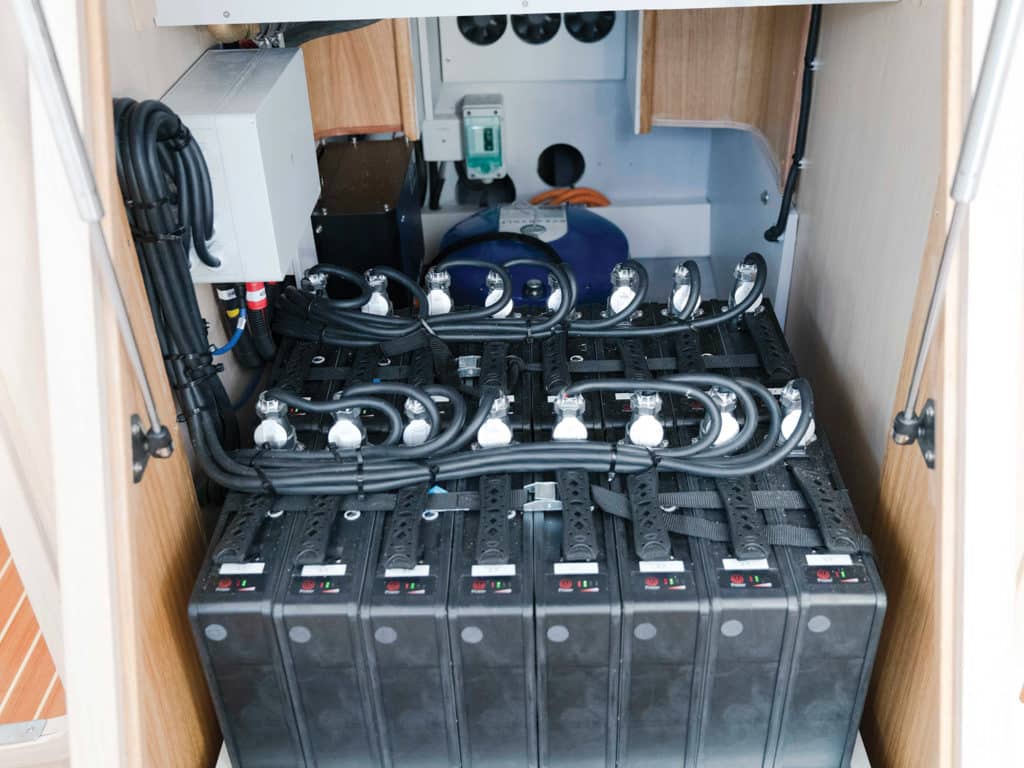
For our sea trial, Balch was joined by Derek Rupe, CEO of Oceanvolt USA. “If you can sail the boat and you have some solar, you can go anywhere in the world, and you can make all your power underway while you go,” Rupe said. When we spoke in October 2020, he touted three high-profile sailors who were using the Oceanvolt electric propulsion system: Alex Thomson, for his Hugo Boss Open 60 Vendée Globe program; Jimmy Cornell, for his Elcano 500 expedition; and Riley Whitelum and Elayna Carausu, who had been teasing their new boat for months on their popular Sailing La Vagabonde YouTube channel.
The efficiency of Oceanvolt’s ServoProp and the regeneration from it is the promised game-changer in each of these boats. The ServoProp is a leg with a feathering propeller that can be set for optimal pitch in three modes: forward, reverse and regeneration.
“You don’t need fuel,” Rupe said. “You don’t need to dock; you can go anywhere you want to go and always have the power for living and propulsion.”
That’s the promise. But are there also pitfalls?
Innovation and Risk
Marine electric propulsion is an emerging technology. Compared with the mature and settled technology of diesel engines and lead-acid batteries, electric-propulsion systems—with their electronic controllers and lithium batteries—are in a stage of development best described as adolescent. Every sailor has his or her own tolerance for technical innovation. For the promise of fewer seconds per mile, grand-prix-racing sailors willingly trade a high risk of expensive damage to the sails, rig or the boat’s structure itself; cruising sailors, by contrast, tend to favor yearslong reliability in their equipment as they seek miles per day.
Folks who identify as early adopters take special joy in the first-wave discoveries of a new technology; if they’re clear-eyed about supporting an ongoing experiment, they see themselves as partners with the developers, accepting failures as opportunities for learning. Sailors motivated primarily by changing the trajectory of climate change might be especially willing to modify their behavior to limit their own output of greenhouse gases. Investing in any emerging technology asks you to start with a clear assessment of your own risk tolerance. We’ll return to this theme with one or two real-life examples.
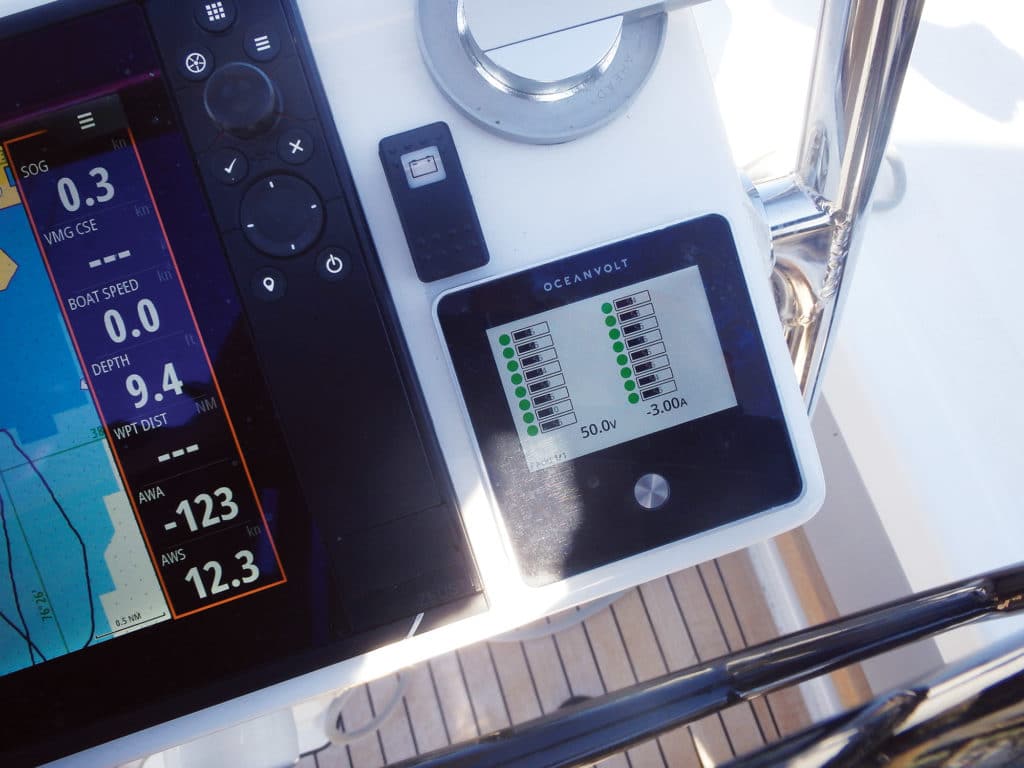
The American Boat and Yacht Council, founded in 1954, sets recommended standards for systems installed on recreational boats. For decades, ABYC has published standards related to installations of diesel and gasoline engines, as well as electrical systems based around lead-acid batteries. By contrast, it was only three years ago that ABYC came out with its first electric-propulsion standard (revised July 2021). And only last year it published its first technical-information report on lithium batteries (a technical-information report is an early step toward a future standard). The takeaway is that if you need help servicing your diesel engine or electrical system built around lead-acid batteries, you can pull into any reasonable-size port and find competent technicians to help you. With electric propulsion and lithium batteries, that pool of skilled talent is significantly scarcer.
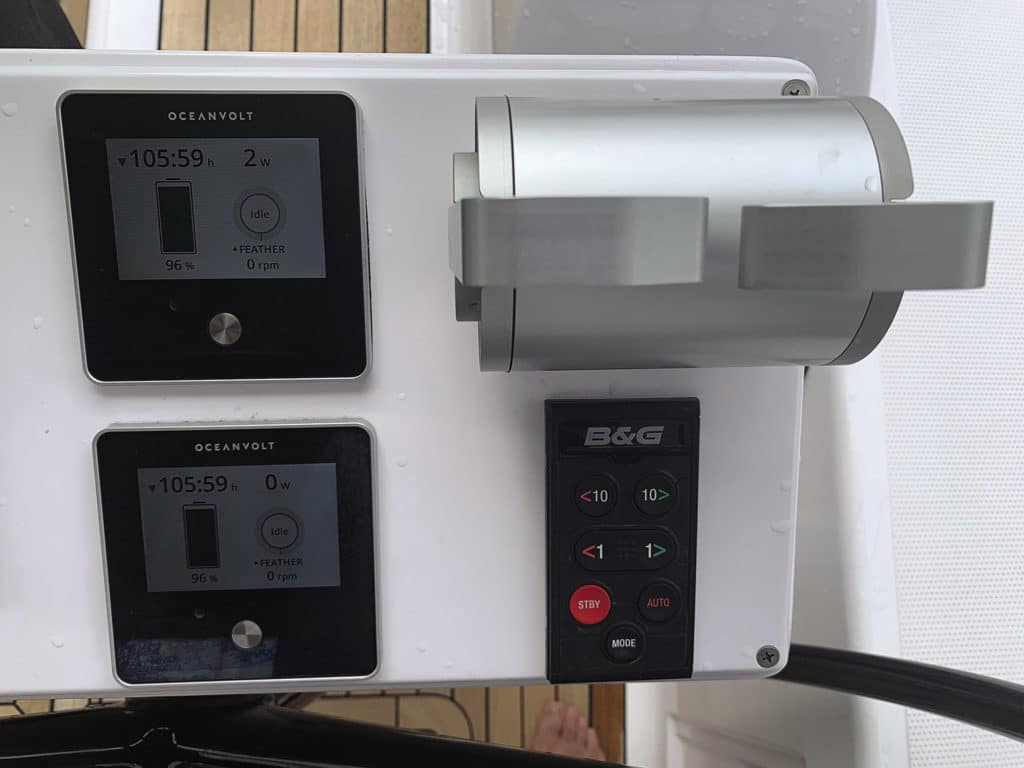
To say that a technology is mature simply means that we’ve learned to live with it, warts and all, but that it holds few remaining surprises. Certainly, diesel-propulsion and lead-acid-battery technologies each leave plenty of room for improvement. When a charge of fuel ignites in the combustion chamber of a diesel engine, some three-quarters of the energy is lost in heat and the mechanical inefficiencies of converting reciprocating motion to rotation. Lead-acid batteries become damaged if we routinely discharge more than half of their capacity. During charging, they’re slow to take the electrons we could deliver.
Lithium batteries are comparatively full of promise. Their power density is far greater than that of lead-acid batteries, meaning they’re much lighter for a given capacity. They’re capable of being deeply discharged, which means you can use far more of the bank’s capacity, not merely the first half. And they accept a charge much more quickly; compare that to several hours a day running an engine to keep the beers iced down.
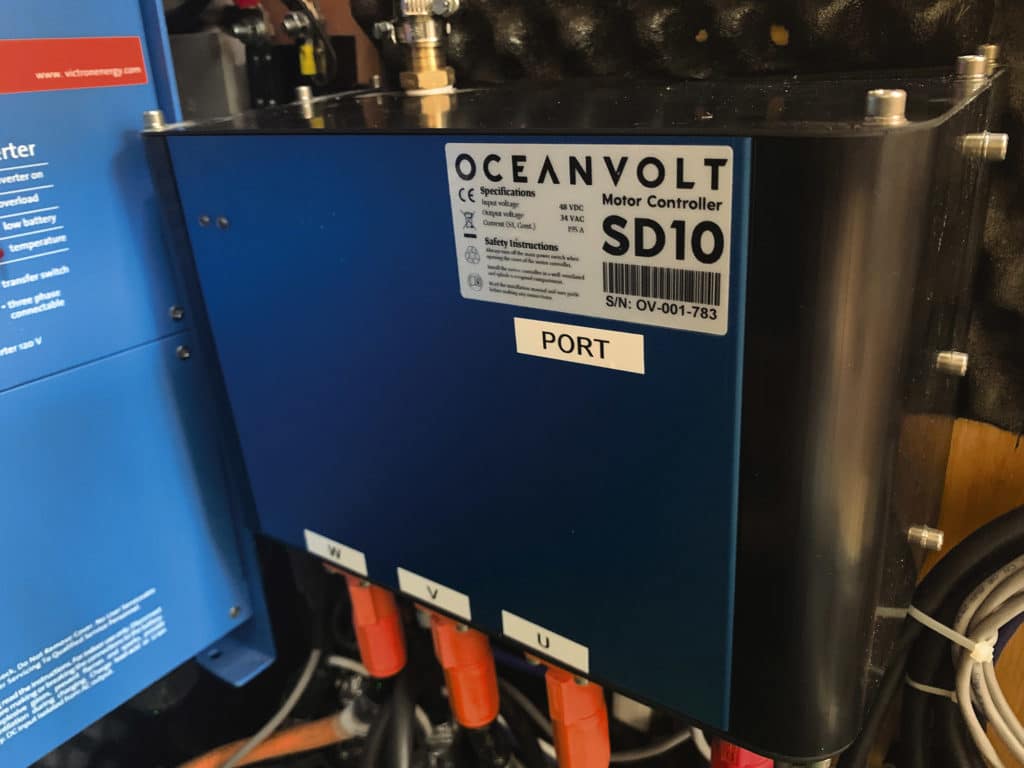
But the pitfalls? Let’s start with ABYC TE-13, Lithium Ion Batteries. Some of its language is bracing. “Lithium ion batteries are unlike lead-acid batteries in two important respects,” the report says. “1) The electrolyte within most lithium ion batteries is flammable. 2) Under certain fault conditions, lithium ion batteries can enter a condition known as thermal runaway, which results in rapid internal heating. Once initiated, it is a self-perpetuating and exothermic reaction that can be difficult to halt.”
Thermal runaway? Difficult to halt? Self-perpetuating?
“Typically, the best approach is to remove heat as fast as possible, which is most effectively done by flooding the battery with water,” TE-13 continues, “although this may have serious consequences for the boat’s electrical systems, machinery, buoyancy, etc.”
If you were following the news in January 2013, you might remember the story of Japan Airlines Flight 008. Shortly after landing at Boston’s Logan Airport, a mechanic opened the aft electronic equipment bay of the Boeing 787-8 to find smoke and flames billowing from the auxiliary-power unit. The fire extinguisher he used didn’t put out the flames. Eventually Boston firefighters put out the fire with Halotron, but when removing the still-hissing batteries from the plane, one of the firefighters was burned through his professional protective gear.
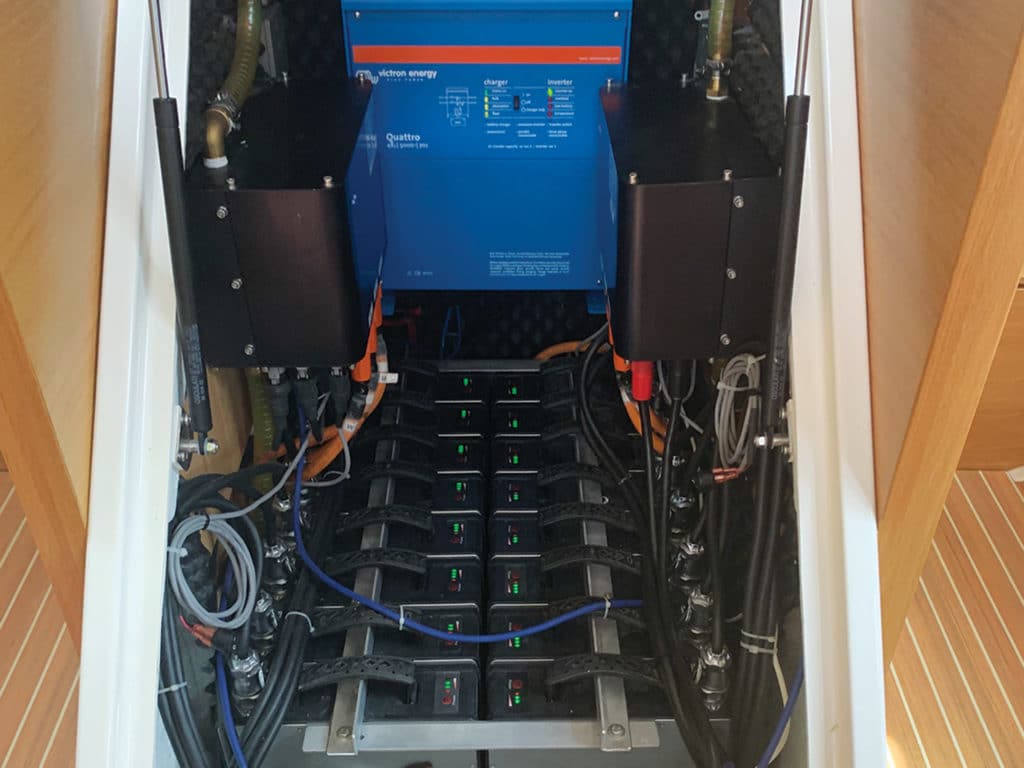
Samsung Galaxy cellphones, MacBook Pro laptops, powered skateboards—in the past decade, these and other devices have been recalled after their lithium batteries burned up. In that period, several high-end custom boats were declared a total loss following failures from lithium batteries. In March 2021, a 78-foot Norwegian hybrid-powered tour boat, built in 2019 with a 790 kW capacity battery bank, experienced thermal runaway that kept firefighters on watch for several days after the crew safely abandoned the ship.
Yes, experts are learning a lot about how to mitigate the risks around lithium batteries. But we’re still on the learning curve.
ABYC’s TE-13 “System Design” section starts, “All lithium-ion battery systems should have a battery management system (BMS) installed to prevent damage to the battery and provide for battery shutoff if potentially dangerous conditions exist.” It defines a bank’s “safe operating envelope” according to such parameters as high- and low-voltage limits, charging and discharging temperature limits, and charging and discharging current limits.
Graham Balch takes these safety recommendations a step further: “To our knowledge, the BMS has to monitor at the cell level. With most batteries, the BMS monitors at the module level.” The difference? “Let’s say you have 24 cells inside the battery module, and three of them stop working. Well, the other 21 have to work harder to compensate for those three. And that’s where thermal events occur.”
Balch followed the story of the Norwegian tour boat this past spring. He believes that the battery installation in that case didn’t meet waterproofing standards: “The hypothesis is that due to water intrusion, there was reverse polarity in one or more of the cells, which is worse than cells simply not working. It means that they’re actively working against the other cells. But if the BMS is monitoring only at the module level, you wouldn’t know it.”
On the Green Yachts website, Graham lists five battery manufacturers whose BMS regimes monitor at the cell level. “If I were sailing on an electric boat, whether it be commercial or recreational, I would feel comfortable with having batteries from these five companies and no other,” he said.
The broader takeaway for today’s sailors is that lithium batteries bring their own sets of problems and solutions, which are different from those of conventional propulsion and power-supply technologies. A reasonably skilled sailor could be expected to change fuel filters or bleed a diesel engine if it shuts down in rough conditions. With lithium-ion batteries aboard, an operator needs to understand the causes and remedies of thermal runaway, and be ready to respond if the BMS shuts down the boat’s power.
Real-World Electric Cruising Boats
When we met Oceanvolt’s Derek Rupe a year ago, he and his wife had taken their all-electric boat to the Bahamas and back the previous season. Before that, he’d been installing electric-propulsion packages for six years on new Alerion 41s and other refit projects. “My real passion is on the technical side of things—installations, really getting that right. That’s half the picture. The technology is there, but it needs to be installed correctly.”
When talking to Rupe, I immediately encountered my first learning curve. I posed questions about the Oceanvolt system in amps and amp-hours; he responded in watts and kilowatt-hours. This was yet another example of the different mindset sailors of electric boats need to hold. Why? Because most cruising boats have just one or two electrical systems: DC and AC. The AC system might operate at 110 or 220 volts; the DC side might operate at 12 or 24 volts. On your own boat, that voltage is a given. From there we tend to think in terms of amps needed to power a load, and amp-hours of capacity in our battery banks. Going back to basics, the power formula tells us that power (watts) equals electrical potential (volts) times current (amps). If your boat’s electrical system is 12 volts and you know that your windlass is rated at 400 watts, it follows that the windlass is rated to draw 33 amps.
But an all-electric boat might comprise several systems at different voltages. A single battery bank might supply cabin lights at 12 volts DC; winches and windlasses at 24 volts DC; the propulsion motor at 48 volts DC; and an induction stove, microwave and television at 110 volts AC. A DC-to-DC power converter steps the voltage up or down, and an inverter changes DC to AC. Instead of translating through all those systems, the Oceanvolt monitor (and Derek Rupe) simply reports in watts coming in or going out of the bank.
“We keep all our thoughts in watts,” Rupe said. “Watts count in the AC induction. They count in the DC-to-DC converter. They count the solar in. They count the hydrogeneration in. And the power-management systems tracks it that way for shore-power in.
“On a boat like this, maybe I have 500 watts coming in the solar panels,” he continued. “So then I can think: ‘Well, my fridge is using 90 watts. My boat has an electric stove. When I cook a big meal, I can see that for every hour we cook, we lose about 10 to 12 minutes of our cruising range.’”
During his Bahamas cruising season, Rupe observed that on days that they were sailing, the combination of solar panels and hydroregeneration supplied all the power he and his wife needed. “When we weren’t sailing,” he said, “we found that we were losing 8 percent each day, in the difference from what the sun gave us to what we were using for the fridge, lights, charging our laptops, and all that stuff.”
Rupe’s solution? “Twice in Eleuthera and once outside Major’s, we went out and sailed laps for a couple of hours because the batteries were below 30 percent of capacity. It was good sailing, and the wind was coming over the shore, so we didn’t have any sea state. We did a couple of hot laps on nice beam reaches, and generated about 700 watts an hour.”
Of the three sailors Rupe touted in October 2020—Alex Thomson, Jimmy Cornell and the Sailing La Vagabonde couple—only Cornell can report back on his all-electric experiences with Oceanvolt. Alex Thomson ended his circumnavigation abruptly last November, just 20 days after the Vendée Globe start, when Hugo Boss collided with an object in the South Atlantic. And at press time in early fall 2021, Riley and Elayna had just recently announced the build of their new Rapido trimaran; keep an eye on their YouTube channel for more about their experiences with the Oceanvolt propulsion system.
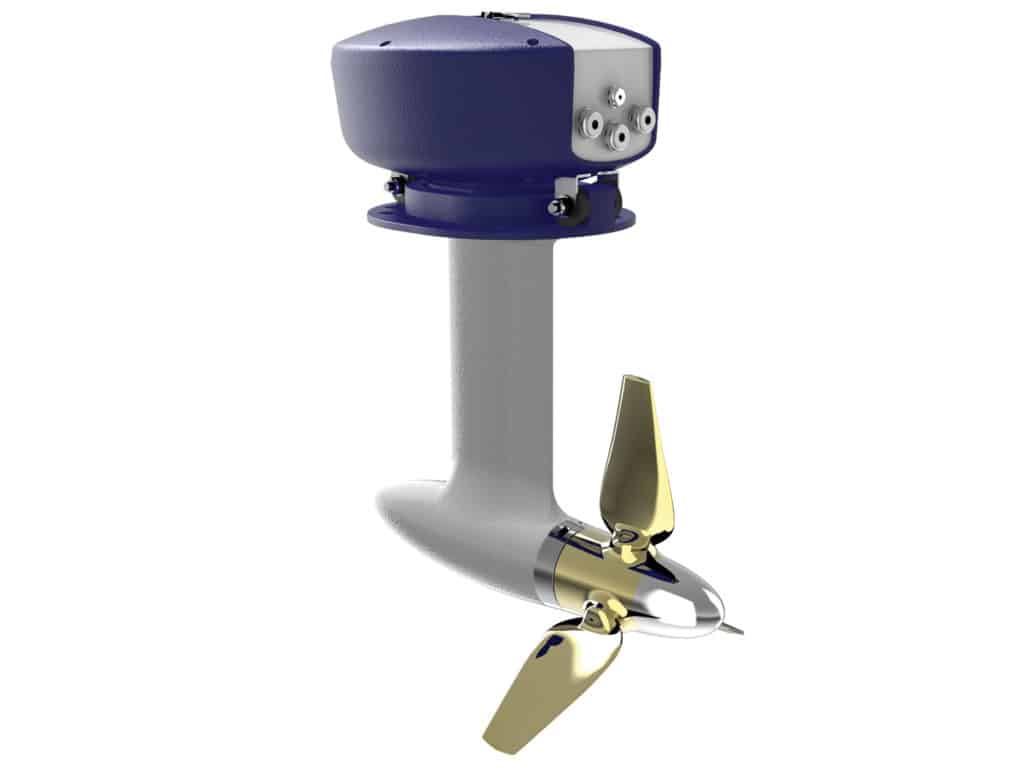
As for Cornell—circumnavigator, World Cruising Routes author, creator of the transoceanic rally, and veteran of some 200,000 ocean miles—he suspended his planned Elcano 500 round-the-world expedition solely because of the Oceanvolt system in his new Outremer catamaran. His Aventura Zero Logs on the Cornell Sailing website, particularly the Electric Shock article posted on December 2, 2020, are essential reading for any sailor interested in sailing an electric boat. “Sailing around the world on an electric boat with zero emissions along the route of the first circumnavigation was such a tempting opportunity to do something meaningful and in tune with our concern for protecting the environment that my family agreed I should do it,” Cornell wrote. “What this passage has shown was that in spite of all our efforts to save energy, we were unable to regenerate sufficient electricity to cover consumption and top up the batteries.”
Cornell’s experience in that article is raw, and his tone in that moment bitterly disappointed. We recommend it as essential reading—not as a final rejection of the electric-boat concept or of Oceanvolt’s system, or even as an endorsement of Cornell’s own decision that the system didn’t work. I suspect that I may have arrived at the same conclusion. Yet given the same boat in the same conditions, one imagines that a new breed of sailor—a Graham Balch or a Derek Rupe—may have responded differently to the constraints imposed by an all-electric boat, as nearly every cruising sailor today habitually responds to the inconvenient constraints of diesel engines and lead-acid batteries.
“If you bring electric winches, electric heads and an induction stove, and then sail into a high-pressure system, you’ll set yourself up for failure,” Balch said. “You have to balance your power inputs and your power outputs.
“Sailing an electric boat is a return to the tradition of sailing that the crutch of a diesel engine has gotten us away from,” he added. “Magellan’s fleet got all the way around the world, and they didn’t have a diesel engine.”
Tim Murphy is a Cruising World editor-at-large and longtime Boat of the Year judge.
- More: Green Wakes , Hands-On Sailor , navigation , print nov 2021 , sailboat review , Sailboat Reviews
- More Sailboats

Pre-Owned: 1988 Hylas 47

Catalina Introduces the 6 Series

Sailboat Preview: Elan GT6 Explorer

For Sale: 1984 Camper & Nicholsons 58

Galápagos: A Paradise Worth the Paperwork

Around Alone

Grease the Wheels of Your Boat: A Guide to Proper Lubrication

A Bowsprit Reborn: A DIY Renovation Story
- Digital Edition
- Customer Service
- Privacy Policy
- Terms of Use
- Email Newsletters
- Cruising World
- Sailing World
- Salt Water Sportsman
- Sport Fishing
- Wakeboarding

Arcona 415 Unveiled: The Sailing Yacht With Electric Propulsion As Standard

The Arcona 415 is the first series produced sailing yacht with electric propulsion as standard. Electric propulsion is already available across all the Arcona fleet as an upgrade option and Arcona Yachts has the largest fleet of electric ‘zero emissions’ yachts on the water, the first being the Arcona 380Z launched in 2015.
Arcona performance cruisers will always sail beautifully but in light winds, when you need to use the engine, electric propulsion is the way forward. The sleek and light hull design works well with electric propulsion.

In response to customer demand, the Arcona 415 has the option of a three or two cabin version with an additional en suite in the owner´s cabin.
The Arcona 415, with her modern hull shape, open transom, more accessible stowage space and increased light, continues the tradition of Arcona 410 as a quality performance cruiser, built with attention to detail. In terms of power, the Arcona 415 is equipped with an Oceanvolt Servoprop 15kW electric propulsion system, with variable pitch propeller technology. It has a 19kWh battery pack as standard. A 15kW electric motor is the equivalent of a 50hp diesel engine on our 40-43ft yachts.

For the propulsion system, Arcona works with Oceanvolt. The lightweight system uses hydro regeneration via the propeller to regenerate power whilst sailing, storing it in the propulsion battery pack for later use. Regeneration depends on sailing speed, however our customers have seen the hydro regeneration commence when the yacht is sailing at a speed as low as 3.3knots.

The benefits of electric propulsion are numerous; not having an exhaust and the elimination therefore of emissions, the ongoing cost saving vs. fuelling up with diesel, the minimised operating noise and vibrations, the increased space for living, the complete power management, the ease of use and maintenance, and having an overall lighter weight thus increased performance.
Beneteau Introduces the New First 30… the Planing Cruiser
Grand soleil 52 performance: new life to the myth, nautor swan merges with sanlorenzo group, royal huisman project 410, ready to roll the hull, live your passion, subscribe to our mailing list.

New Arcona 415 – The first yacht with Zero Emissions propulsion as standard
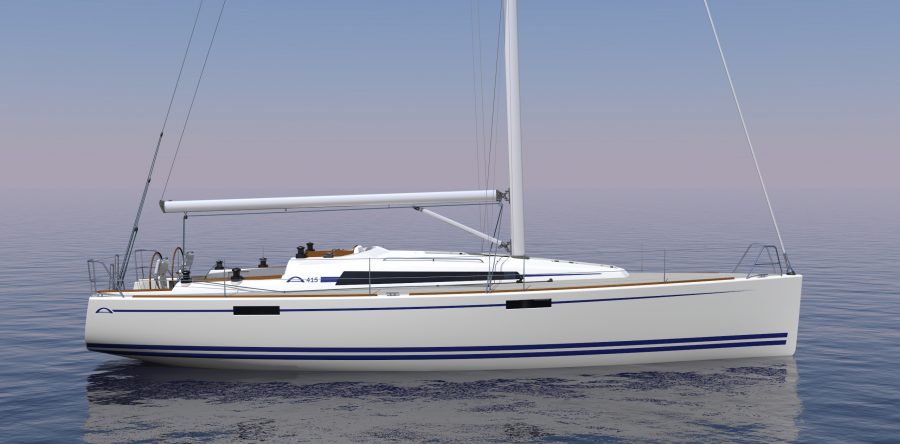
Arcona Yachts press release
Gustavsberg, Sweden 18.8.2021 - Arcona Yachts is delighted to announce the launch of the new Arcona 415 , the first series produced sailing yacht with electric propulsion as standard.
Electric propulsion is already available across all of the Arcona fleet as an upgrade option and Arcona Yachts are proud to have the largest fleet of electric ‘zero emissions’ yachts on the water, the first being the Arcona 380Z launched in 2015.
Urban Lagnéus, Arcona Yachts CEO says, “Electric is here to stay. Our performance cruisers will always sail beautifully but in light winds, when you need to use the engine, electric propulsion is the way forward. The sleek and light hull design works extraordinarily well with electric propulsion. The ability to spend your leisure time at sea without emissions, and yet gain advantages in comfort and performance, opens up a new world of opportunities for our normal usage”.
“The needs of our customers are changing, and we wanted to evolve the design of the Arcona 415 to respond to this. Customers often ask us for a yacht that has the space to sail with friends or grown-up family members, so the option of a three or two cabin version with an additional en suite in the owners’ cabin is increasingly requested.”
The Arcona 415, with her beautiful lines, modern hull shape, open transom, more accessible stowage space and increased light, continues the tradition of Arcona 410 as a quality performance cruiser built with superb attention to detail, as always. In terms of power, a 15kW electric motor is the equivalent of a 50hp diesel engine on our 40-43ft yachts.
For the propulsion system we are proud to work with Oceanvolt, who represent the world's absolute top companies when it comes to design and manufacturing of electric motor systems. The lightweight system uses hydro regeneration via the propeller to regenerate power whilst sailing, storing it in the propulsion battery pack for later use. Regeneration depends on sailing speed, however our customers have seen the hydro regeneration commence when the yacht is sailing at a speed as low as 3.3knots.”
The benefits of electric propulsion are numerous; not having an exhaust and the elimination therefore of emissions, the ongoing cost saving vs. fuelling up with diesel, the minimised operating noise and vibrations, the increased space for living, the complete power management, the ease of use and maintenance, and having an overall lighter weight thus increased performance.
Urban Lagnéus continues, “We can all do our bit to combat climate change, and to be the first yacht builders with zero emission propulsion as a standard is an important step towards further enjoyment of sailing the Arcona way. The new features on the Arcona 415, and the electric propulsion as a standard have been introduced to ensure that the Arcona 415 remains at the forefront of modern performance cruisers on the market today.”
For further details on the Arcona 415, please contact [email protected] , visit arconayachts.se or call +46 8 519 410 40.

Written by Anna
View all posts by: Anna
Comments are closed.
- Sponsorships
- Hydrogenerator
- Battery Technology
- Environmental
- Equipment and Services
- Ferries and Cruises
- Marine Construction
- Marine Renewables
- Naval Projects
- Onboard Systems
- Ports and Harbours
- Power and Propulsion
- Shipyards and Shipbuilding
- Vessel Build and Maintenance
- Online Magazines
- Supplier Spotlight

Arcona launches first series-production zero-emission yachts
Arcona Yachts of Sweden has launched its latest model, the Arcona 415, which the company claims is the first series-produced sailing yacht with electric propulsion as standard. The company launched its first zero-emission vessel, the Arcona 380Z, in 2015, and electric propulsion is available across the Arcona fleet as an upgrade option.
Urban Lagnéus, Arcona Yachts CEO, said, “Electric is here to stay. Our performance cruisers will always sail beautifully but in light winds, when you need to use the engine, electric propulsion is the way forward. The sleek and light hull design works extraordinarily well with electric propulsion. The ability to spend your leisure time at sea without emissions, yet gain advantages in comfort and performance, opens up a new world of opportunities for our normal usage.”
The 415 is propelled by a 15kW electric motor supplied by Oceanvolt, which the company says provides similar performance to its 50hp diesel engines. The system uses hydro regeneration via the propeller to regenerate power while sailing, storing it in the propulsion battery pack for later use. Regeneration depends on sailing speed. However, according to Lagnéus, “Our customers have seen the hydro regeneration commence when the yacht is sailing at a speed as low as 3.3kts.”
Related Posts
Hypermotive and honda collaborate to create a hydrogen fuel cell power system, abb and seafjord energy introduce e-bunker vessel concept, boluda towage orders four hybrid tugs from damen shipyards.
Type above and press Enter to search. Press Esc to cancel.
Privacy Overview
| Cookie | Duration | Description |
|---|---|---|
| cookielawinfo-checbox-analytics | 11 months | This cookie is set by GDPR Cookie Consent plugin. The cookie is used to store the user consent for the cookies in the category "Analytics". |
| cookielawinfo-checbox-functional | 11 months | The cookie is set by GDPR cookie consent to record the user consent for the cookies in the category "Functional". |
| cookielawinfo-checbox-others | 11 months | This cookie is set by GDPR Cookie Consent plugin. The cookie is used to store the user consent for the cookies in the category "Other. |
| cookielawinfo-checkbox-necessary | 11 months | This cookie is set by GDPR Cookie Consent plugin. The cookies is used to store the user consent for the cookies in the category "Necessary". |
| cookielawinfo-checkbox-performance | 11 months | This cookie is set by GDPR Cookie Consent plugin. The cookie is used to store the user consent for the cookies in the category "Performance". |
| viewed_cookie_policy | 11 months | The cookie is set by the GDPR Cookie Consent plugin and is used to store whether or not user has consented to the use of cookies. It does not store any personal data. |
Functional cookies help to perform certain functionalities like sharing the content of the website on social media platforms, collect feedbacks, and other third-party features.
Performance cookies are used to understand and analyze the key performance indexes of the website which helps in delivering a better user experience for the visitors.
Analytical cookies are used to understand how visitors interact with the website. These cookies help provide information on metrics the number of visitors, bounce rate, traffic source, etc.
Advertisement cookies are used to provide visitors with relevant ads and marketing campaigns. These cookies track visitors across websites and collect information to provide customized ads.
Other uncategorized cookies are those that are being analyzed and have not been classified into a category as yet.

- Allures yachting
- Garcia yachts
- Dufour yachts
- Fountaine Pajot Sailing Catamarans
- Outremer catamarans
- Catana catamarans
- Garcia Explocat
- Dufour catamarans
- Aventura catamarans
- NEEL Trimarans
- Allures Sailing Catamarans
- Fountaine Pajot Motor Yachts
- Garcia trawler
- Beneteau Motorboats
- Aventura Power Catamarans
- Yacht school
First look: the magnificent Arcona 415
Despite the instability of global trends and announcements, as well as against the background of the global cancellation of various events, one thing remains unchanged - the announcements of new boats! Today's guest is Arcona 415.
The Arcona 415 is equipped with an electric propulsion system as standard. It is this boat that drives the brand towards more sustainable yachts. The company's goal is to make sustainable yachts truly serial.
The new Arcona 415 is marketed as the first production yacht with an electric propulsion system as standard.
Arcona's previous experience
Arcona has extensive experience in the development of boats with additional electric motors. It all started with the 380Z, which was launched in 2015. In addition to the electric motor, this yacht was equipped with a large number of solar panels, including those that were built into the fabric of the mainsail.
Much has changed since then. There are many new ways to make such a yacht more practical and sustainable. For example, the cost of solar panels continues to decline, and there are more opportunities to generate electricity from a propeller while sailing.
However, perhaps the biggest and most important achievement has been lithium-ion batteries. Every year they become 20% more powerful, while remaining the same in size and cost. Therefore, today for the same money you can buy a storage battery, the capacity of which is twice as much as four years ago.
How does the Arcona 415 differ from the “sisters”?
Like other Arcona projects, the 415 is a powerful cruiser. The platform on which this boat was developed is the Arcona 410 model. The 410th has been produced for more than 10 years and the 415th has a number of differences. So, among the modifications and updates of the 415th, a more open transom and enlarged windows were noticed.
The standard motor is 15 kW Oceanvolt. A 19 kW lithium-ion battery is also standard. There is a backup set of two AGM batteries with a capacity of 90 A / h. “Electricity is here and now,” says Arcona CEO Urban Lagneus. "Our cruisers will always sail beautifully, but in light winds where the engine must be used, electric propulsion is the right choice."
Specifications
Length: 12.2m / 40ft 0in
Maximum width: 3.9m / 12ft 10in
Draft: 2.0; 2.2 or 2.5 m / 6 ft 7 in; 7'3 "or 8'2"
Displacement: 7,800 kg / 17,200 lb
Main sail armament: 175 sq.m.
News and articles

Below is an overview of the new 2019 30-foot day sailers and full-fledged cruisers, which premiered at the Düsseldorf Boat Show.

The new Astrea 42 sailing catamaran from Fountaine Pajot has won the prestigious 2019 European Yacht of the Year award at Boot Dusseldorf. The stunning yacht has been honored with this honor despite a large selection of multihulls of all sizes. Along with the 2018 Multihull of the Year award, the new award confirms Astrea 42's status as the world's best cruising catamaran.

Breaking news: Boot 2022 will not take place. It has been postponed to the 2023 calendar year.

Price is not available
Price data is acquired from numerous open sources and aggregated, it can only be used as a rough starting point and not a precise tool for comparison.
It most cases price:
- does not include VAT
- does not include delivery to a client
- accurate only for most basic options
Final price might be 30%-80% higher if you choose high specification.
2.0 m - 2.5 m
Anchored boats.
Look for this area at top right corner of the page.
Read reviews and tests

First look: Arcona 415 – first electric production yacht? - Yachting Monthly

New Arcona 415 first sailing yacht with electric propulsion standard - Plugboats
Similar boats, catalina 355.
from EUR 192,000
Boats by Arcona

The Plugboats Directory of Electric Boats is part of the world’s most comprehensive directories of electric boat resources, with information on over 625 suppliers worldwide.
Dealers, Distributors and Manufacturers of every kind of electric boat – powerboats and sailboats, small runabouts and ribs to ocean going yachts – can be found using the search dropdowns to select Boat Type and/or Business Type and/or Country or search by Keyword or business name.
The results will appear »» further down the page . Click on any logo for contact and more information about the company.
If you have an addition, correction or suggestion to improve this directory, please use the Plugboats contact form at the bottom of the page.
»» Go to Search Results
Other plugboats supplier directories.
Boats: Powerboats, Sailboats, PWCs, Boards Boat Shows Accessories: Batteries, Chargers, Solar etc. Motors: Inboards, Outboards, Pods, Saildrives, Trolling, ‘IOs’ and ‘Z-Drives’ Refits, Conversions, Service Rentals, Charters, Tours, Cruises Associations All Categories
Plugboats Buying Guides
Plugboats also has Buying Guides that provide power ratings, motor type, weight and other specifications for individual models of electric boat motors – including MSRP price in many instances. Out Batteries Guide is a useful explainer of the energy source for an e-boat.
Outboard Motors Less than 5kW Outboard Motors More than 5kW Inboard Motors Pods and Saildrives Trolling Motors Batteries
SEARCH RESULTS
Refine your search using the options at the top of the page or select ‘Clear Search’ below to begin a fresh search.
Arcona Yachts
The Arcona 415 is one of the first series produced sailing yachts with electric propulsion as standard.
Electric propulsion is already available across all the Arcona fleet as an upgrade option and Arcona Yachts is proud to have the largest fleet of electric ‘zero emissions’ yachts on the water, the first being the Arcona 380Z launched in 2015.

CRUISING BOATS
Pontoon boats, sport boats, solar boats.
Do you have an addition, correction or suggestion to make the Plugboats Directory of electric boats better? Please let us know:

Get all the latest electric boats and boating news delivered to your mailbox!
Sign up here for the Plugboats newsletter.
IT’S FREE!
Email address:
Terms and Conditions - Privacy Policy
Yachting Monthly
- Digital edition

Electric yacht: What are the options for going electric?
- Will Bruton
- July 17, 2020
The options for having an electric yacht or a hybrid-electric yacht are growing in popularity; we outline the current options for those making the switch

The Arcona 380Z is a standard production yacht that has been adapted for electric propulsion. Note the increased solar panel surface area with soft panels bonded to the sails. Credit: Jukka Pakainen
A modern electric yacht can come in all shapes and sizes, from the latest high-tech speed boats with recently developed high-performance electric engines, to a traditional tender with an electric outboard on the back. Increasingly yachts are going electric too as electric engines become increasingly capable of propelling boats weighing several tonnes, and with the rigging for sails, at a reasonable speed for an acceptable length of time.
Since the invention of the marinised engine , there has never been the capacity to store enough fuel to cover significant distances in boats that are smaller than a tanker, with fuel capacity always being the limiting factor. As such the best way to cover long distances on a boat fit for a small number of passengers was, and remains, wind power.
For all the many green attributes that using the power of wind offers, there is no escaping that for most, fossil fuels still represent some part of sailing – whether that be a diesel engine to motor in light winds, onto and off a mooring , or to generate power for onboard electronic systems. Even a small tender used to go from ship-to-shore is often fitted with an outboard motor.
Recent advances in electric power, however, have started to make electric propulsion a reasonable alternative to fossil fuel power. Range will always be an issue but that has long been true of a traditional diesel engine. Improvements in lithuim-ion battery performance is, and likely will continue to, increase range every year.
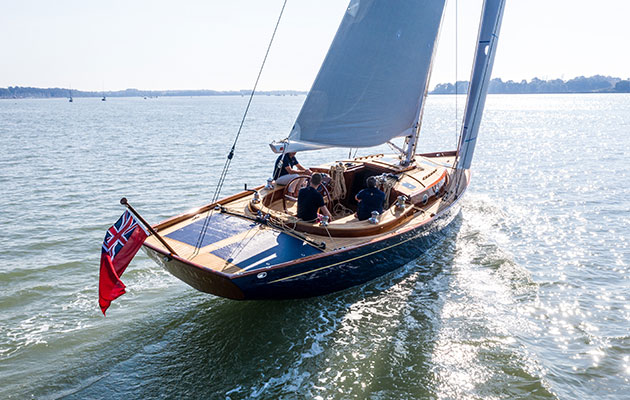
Spirit Yachts 44e – the ‘e’ stands for electric
Additionally electric power and batteries offer the bonus of being able to be recharged via solar panels , a wind turbine or hydroelectric power – via a hydrogenerator mounted on the stern of a boat sailing.
At first glance the electric yacht market could appear in its infancy, but like every revolution, the will of the people is driving forward technology that only a few years ago was seen as the stuff of fantasy.
The market has responded to demand, and battery and motor technology has come on leaps and bounds, driven in part by the rapid development of electric cars.
It may not be commonplace yet, but electric yachting is here, even available ‘off the shelf’, so is it time to get onboard?

The Spirit 111 is a bold hybrid yacht, promising 30 miles motoring under electric power alone. Credit: Ian Roman/Waterline Media
A cutting edge electric yacht
Like Formula One, it’s the cutting edge of electric yachting that trickles down into mainstream production in no time at all.
For Spirit Yachts, a builder defined by a unique blend of traditional and state-of-the-art, electric yachting has been driven by demanding clients that want their yachts to be at the cutting edge.
Spirit Yachts have now produced a number of projects aimed at the all electric luxury yacht market including the Spirit 44e electric yacht and a recent project, the Spirit 111, had all the hallmarks of a superyacht project and the team had to earn their keep delivering to brief.
Managing Director Nigel Stuart explained how it works.
‘The 111 combines several cutting-edge technologies to deliver a something that’s never really been done before. A lithium-ion powered electric drive system can be charged by hydrogenation and also two high-wattage diesel generators.
‘Each generator is 22kw, meaning they can pack a lot of power into the system in a short period of time, they don’t need to run for long to fully recharge.
‘The prop is both a means of drive and power generation, so no separate hydrogenerator is needed. She will be capable of motoring under electric alone for more than 30 miles.
‘When you take on a project that’s electric, it makes you think hard about efficiency so the air conditioning, water heaters and everything in the galley has also been carefully selected to use less power.
‘For her owner there is very little compromise and some major advantages.’
Whilst it’s a long way from the average cruising yacht, the trickle-down effect of projects like the Spirit 111 can’t be underestimated.

Calypso , a Contessa 32, was the yard’s first foray into electric-powered yachts. Credit: Jeremy Rogers
Traditional electric yacht
Jeremy Rogers’ yard in Lymington is the birthplace of the iconic Contessa designs and a veritable temple to long keeled , traditional craft.
Less well known is the yard’s interest in electric auxiliary engines, something they have been involved in for more than 10 years.
Their first project, the refit of a Contessa 32 called Calypso, was an experiment by the Rogers family to see what was possible.
‘ Calypso was a test bed in the technology’s infancy,’ explains Kit Rogers of this early electric boat.
‘Inevitably, we didn’t get it all right, but we learned a lot about the dos and don’ts of electric yachting. The end result was a hybrid. The more we did, the more interesting the project became.
‘It’s not just the obvious, silent peaceful propulsion; it’s also the things you take for granted about a cruising boat. For example, no gas, we didn’t need it because we had electric power.
The yard has also worked on an electric folkboat conversion for a foreign customer.
‘The client, first and foremost, loves to sail. He sees the electric as an auxiliary option, along with the rowing and is excited to own a boat that’s quietly different.
‘He’s looking for a more connected experience and an electric boat helps him achieve it. When you’ve been motoring in and out of marinas under chugging diesel engines for years, the electric motor is something of a revelation.

Arcona has installed solar sails on its latest 380Z electric yacht
Off-the-shelf electric yacht
Perhaps the biggest indication of the future of the electric boat is the willingness of production and semi-production builders to pin their flags to the mast and embrace it.
One of the first was Hanse, who developed a version of their 315 utilising a Torquedo electric pod system.
Providing around the same amount of power as a 10 horsepower diesel, a 4.4kWh lithium ion battery pack powers the system.
Arcona, Dufour, Elan and Delphia also have electric boat models and are each taking their own direction on entering the market.
Arcona’s 380Z (the ‘Z’ stands for ‘zero emission’) fully electric boat has solar panel covered sails, capitalising on the large surface area to top up batteries under sail.
In the multihull market, there is even more scope for solar, wind and hydrogenation due to the horizontal surface area available for solar charging.
What are the options for an electric yacht?
Pure electric.
Purely electric systems can be broadly divided into two categories, high and low voltage.
The latter is the simplest option in terms of how it works and requires less specialist knowledge to install.
Kit Rogers installed a 48v Ocean Volt system in his latest project and remarked on the experience.
‘The advantage of the low voltage system is its inherent lack of complexity. Whilst we’ve coupled it with lithium ion battery technology, it can also be wired up to conventional lead acid batteries. There are pros and cons to both. What surprises everyone is the size, it’s a tiny motor and is surrounded by lots of space where the engine would normally sit.’
High voltage systems are more advanced, and utilising lithium-ion technology, their capacity is improving year on year.
For larger yachts this is generally seen as a better option.
A partnership between BMW and Torqueedo has led to the development of the Deep Blue 315v high voltage battery.
Effectively the same unit as found in the BMWi3 electric cars now often seen on the high street, the system produces a lot of power and is being used on the Spirit 111 project as well as catamarans.
Electric hybrid
One big barrier to entry exists for most potential electric yacht buyers – range.
Even the most advanced set-ups are limited to a maximum of a few hours motoring at cruising speed.
‘The electric motors excel at two things in particular,’ explained Kit Rogers.
‘The first is as auxiliary power for getting in and out of marinas. The second is engaged at low power to very efficiently motor-sail in light airs. If you want to do more than that, at present, you need to add a way of packing in the charge into the battery quickly whilst at sea; which means a generator’ .
As with electric cars and as enthusiasm builds for the technology, a hybrid option, pairing a generator with an electric drive system, is already proving popular and is probably the most practical option for those planning to cruise any distance.
Using a large generator, charge can be quickly put into the system when needed.
Once under sail, the yacht’s propeller becomes a hydro generator, meaning that diesel power is not needed day-to-day.
Solar can also be used to add additional charging capacity.
‘When a fully integrated electric hybrid system is incorporated into a cruising yacht from the outset, its possibilities really become clear,’ explains John Arnold, UK manager at Torqeedo.
‘Sailing for days on end with no engine noise is entirely possible. There are other less obvious benefits too. Electric drives have no long rotating shaft, so can be used as pod drives as well, meaning the boat is far more manoeuvrable than even a yacht equipped with bow and stern thrusters.’

Spirit Yachts 44e
How much does it cost to convert a yacht to electric power?
The technology exists, but anyone seriously considering going electric will want to crunch the numbers.
In the case of taking out a traditional inboard diesel and replacing it with an electric system, it’s relatively easy to work this out.
However, unless you include an auxiliary generator, you will be limited to battery range alone.
For this reason, we’ve done a like for like comparison for a 35ft yacht engine refit, including the cost of a generator to make the system a practical hybrid.
Unsurprisingly, at the moment, there’s a big difference in cost, but at between three to six times the cost, it is gradually coming into the realms of possibility, and prices should continue to drop as technology develops and evolves.
Ocean Volt SD10 Motor system (including batteries, charger and 6kw generator): £30,825.16
Beta Marine Beta 20hp Marine Diesel: £4,100
If you enjoyed reading this….
A subscription to Yachting Monthly magazine costs around 40% less than the cover price .
Print and digital editions are available through Magazines Direct – where you can also find the latest deals .
YM is packed with information to help you get the most from your time on the water.
- Take your seamanship to the next level with tips, advice and skills from our experts
- Impartial in-depth reviews of the latest yachts and equipment
- Cruising guides to help you reach those dream destinations
Follow us on Facebook , Twitter and Instagram.
Electric boats
Electric hydrofoil, vessev officially unveils its vs–9 hydrofoil boat inside and out [video].
Just over three months after coming out of stealth mode, young electric hydrofoil boat builder Vessev has shared a closer look at its flagship vessel – the VS–9. Today, the boatbuilder shared fresh images of a completed VS–9 vessel and a detailed video below.
Vessev, formerly known as Seachange, is a young, eco-friendly boat builder founded a few years ago in Auckland, New Zealand. That is where the company currently operates and is conducting sea trials of its flagship vessel, an electric hydrofoil boat called the VS–9 .
Designed for commercial operations and tourism, this electric hydrofoil “flies” above the water, offering a quieter and more efficient option in sea travel that will soon be used as a passenger ferry thanks to NetZero Maritime – the green technology team at Fullers360 – New Zealand’s largest ferry operator, who has already signed on to help commercialize the hydrofoil technology.
Vessev may be young, but it is making (smaller) waves above the water with its hydrofoil boat technology, which is finalizing commercial certification.


Vessev showcases first electric hydrofoil boat build
Today, Vessev publicly shared images and footage of its first completed VS–9 electric hydrofoil boat build. Our previous coverage of the vessel included photos of the boat tub only; the one interior shot we had was a rendering.
The images seen above are a genuine look at what the VS–9 will look like when it begins transporting passengers in New Zealand as soon as certification is complete. Per the company, the flagship electric hydrofoil boat has entered the last phase of sea trails before commercial operations begin with Fullers360.
Vessev explained that the VS–9 is stabilized by foiling technology below the waterline using technology derived from the America’s Cup. Those foils enable the boat’s carbon fiber hull to rise 50 cm above the water, clear of waves and wake.
The result is a vessel that is smoother and quieter while still offering plenty of space for passengers. Per Vessev CEO Eric Laakmann:
Traditionally, larger vessels are required to deliver a comfortable passenger experience as they can handle the impact of waves and wake. By flying above the waves, the VS–9 delivers a large vessel experience on an agile platform that can be berthed and charged in nearly any marina. One way of looking at the impact of this vessel is that our waterways today are like roadways, where the only comfortable mode of transportation are very large multi-passenger buses – i.e. ferries. These large vessels are here to stay, but they will be augmented with point-to-point services delivered by vessels such as the VS–9. It’s like introducing a limo into a world of buses. Through enhanced comfort and reduced operating costs, the VS–9 platform delivers an entirely new transportation experience that hasn’t truly been viable until today.
Today’s fresh images also give us our first look at the electric hydrofoil boat’s interior, which Vessev says was inspired by private jet travel and premium automotive brands like Rivian . It features quality materials and ergonomic seats and armrests to offer passengers added comfort while they enjoy the views from the panoramic windows. Laaakmann again spoke:
In designing the VS–9 transportation configuration, we knew that we wanted to create something that highlights the unique advantages of this technology. She includes stylish seating for 10 where easy conversation can flow between guests while quietly gliding to their destination. The full standing height cabin also includes wraparound glass with panoramic views of the environment around them. Our goal was to make sure the passengers of the VS–9 are connecting with only two things – those on the journey with them as well as their surroundings. We’ve accomplished exactly that.
With ten passengers aboard, the VS-9 can reach a cruising speed of 25 knots (~29 mph) and has a range of 50 nautical miles (57 miles/92.6km). It can recharge its batteries at any marina plug, but that area has a DC fast charger; the VS–9 can recoup 0.8 nautical miles of range per minute.
Vessev hopes it can open up new opportunities for sustainable marine travel in the transport and tourism industries. Looking ahead, the company is already working on a larger vessel called the VS-18 that can transport up to 100 passengers. While we await the arrival of both electric hydrofoil boats, here’s an up-close look at the VS–9, posted by Vessev today:
FTC: We use income earning auto affiliate links. More.

Scooter Doll is a writer, designer and tech enthusiast born in Chicago and based on the West Coast. When he’s not offering the latest tech how tos or insights, he’s probably watching Chicago sports. Please send any tips or suggestions, or dog photos to him at [email protected]

Manage push notifications


What it’s Like to Cross the Atlantic Ocean in an Electric Sailboat
- Electric Yachts
It’s been one month since we crossed the Atlantic Ocean in two electric sailboats, including the Arcona 435Z (Z for zero emission) with Oceanvolt’s first production Servoprop system with advanced hydroregeneration and it’s worth looking back on our trip to reflect on what it was like to sail across the ocean in an electric sailboat.
On the journey, we experienced days with 30+ knot headwinds in which we were double reefed and other days in which we had winds less than 4 knots, ironically as we were passing the wind farms off the coast of England. We had fair winds crossing the Bay of Biscay and 20-30 knots of following winds down the coast of Portugal. From the Canary Islands to Bermuda we mostly had gentle 10-20 knot following winds, though we did get a bit of a scare at the end as Hurricane Paulette doubled in speed and changed direction to come right towards us though we made landfall in plenty of time.
At first, in the North Sea after leaving Sweden, we used the electric propulsion more than we needed as we augmented our speed while sailing. After a few days, our battery bank was down to 20%. Then, we started relying on the sails…as sailors. At first, I felt like we had to and I was frustrated as we sailed along at four knots. But, what triumphed over my frustration is rediscovering within myself what it meant to be a sailor.
For centuries, we sailors made it everywhere on the planet relying 100% on the winds. Relying on the winds made centuries of sailors better at reading the weather, trimming sails and keeping a steady course. Modern sailors know how to do these things, but we have stopped relying on these skills because of the diesel engine. At first on our trip, we turned off the motor because our battery bank was low and we needed to conserve power. But, as our journey continued, we found ourselves enjoying relying on our sails and our sailing skills. We usually entered port with 50% or more of our battery bank due to our combination of using the motor less and hydroregenerating energy back into the battery bank. For example, we did use the Arcona 435Z motor for a long-time to get out of a dead zone of wind leaving the Canary Islands, getting down to around 20%, but through hydroregeneration, we ended up getting back up to 90% and pulling into Bermuda with over 50% charge in our battery bank.
While we had used electric boats of all types in the past, this was our first long, transatlantic journey using an electric sailboat. We learned that an electric motor made us better sailors, reduced the maintenance and fumes one usually deals with on a journey with a diesel engine, and when one gets used to the balance of using the electric motor and regenerating through hydroregeneration and solar power, you in effect, get an unlimited range with an electric motor. Learning how to hydroregenerate and thinking about power management became part of the art of sailing and was enjoyable thinking about how and when to use the motor and hydrogenerate, like we did when using the traveler, mainsheet, and boom vang all in combination to create a well-trimmed sail. In fact, the two went hand in hand as the better we trimmed our sails, the faster we went and the more we could hydroregenerate.
Racers of course, are familiar with relying on their sails and trimming them to get more speed- they have to in races. But cruisers have gotten away from relying on their sails because of the diesel engine. We saw many a sailor who had their mainsail up and the engine on as they powered in a straight line, upwind (and were probably asleep as they did not respond to VHF calls from angry fisherman who had to get out of their way!). This is not what any of us envision when we think about who are are as sailors, and I believe electric propulsion will make cruisers better sailors while still giving them the auxiliary propulsion they need to get out of dead zones and in and out of port.
The advice I would give to any sailor who is thinking about crossing the Atlantic with an electric sailboat is threefold:
- Measure the amp requirements of all your onboard systems and change out any power hungry system. On the Arcona 435Z we had a water-cooled refrigerator, which was a game changer as it significantly decreased the power consumption onboard compared to the other boat that had a typical marine refrigerator.
- Spend time on weekend sails sailing even when the winds are light. It is good for one’s psyche and one’s skills to develop their light wind sailing ability.
- Bring paperback books. In line with our view that modern electric sailboats bring sailors closer to the tradition of sailing in which sailors had no need of a diesel engine to travel the world, we found we read more when we had a real book in our hands and not just a kindle.
And lastly, if you are going to cross the Atlantic in an electric sailboat, it makes a huge difference to do it in a sailboat with three key characteristics:
- Performance – the Arcona 435Z averaged over 8 knots sailing across the ocean, which is fast for a monohull sailboat just over 40 feet. Whether it is a catamaran (that is stable and safe), a big 18+ meter monohull with a long waterline or a higher performance monohull like the whole range of Arcona sailboats, a fast sailboat is a huge plus.
- Comfort – the Arcona 435Z was a joy to spend time on with its comfortable cushions and cabins, it’s well-laid out galley, the expansive dinette and the spacious cockpit that made outdoor lounging relaxing. You’re going to be spending a lot of time on your boat crossing the ocean and it makes a big difference if you get to cross it in a boat that is so incredibly comfortable and well-made as an Arcona.
- Hydroregeneration – hydroregeneration is a game changer for electric propulsion and Oceanvolt’s new Servoprop lineup has the best hydroregeneration capability of any electric propulsion system available on the market. Hydroregeneration continuously adds power back into your battery bank giving you ‘free’ power. If you are using an electric motor, choose one with a strong ability to hydroregenerate because it transforms your range from a few dozen miles to unlimited when used strategically.
Now that we have crossed the ocean in an electric sailboat, I have been asked, do I want to cross the ocean again? My answer is absolutely, but with two requirements:
- Crossing the ocean in an electric sailboat was so enjoyable compared to a sailboat with a diesel engine, I would never want to cross the ocean with a diesel engine ever again (this is pretty similar to how most Tesla owner feels about the idea of going back to driving a gas car).
- The second requirement is personal – I missed my wife and my next ocean crossing will be a shared one with my wonderful life partner because I want to spend the time at sea with her instead of apart.
- Oslo Boat Show
672 Wine Club
- Motorcycles
- Car of the Month
- Destinations
- Men’s Fashion
- Watch Collector
- Art & Collectibles
- Vacation Homes
- Celebrity Homes
- New Construction
- Home Design
- Electronics
- Fine Dining
- Benchmark Wines
- Brian Fox Art
- Disneyland Resort
- Ka La’I Wakiki Beach
- Raffles Hotels & Resorts
- Sports & Leisure
- Health & Wellness
- Best of the Best
- The Ultimate Gift Guide
This New Solar-Electric Catamaran Comes With a Massive, Fold-Down Beach Club
The cosmopolitan 125 can cruise the seas with zero emissions, too., rachel cormack.
Digital Editor
Rachel Cormack's Most Recent Stories
- LVMH Could Become a Major Sponsor of Formula 1
- Rolex Is the Go-To Brand for First-Time Watch Buyers, New Data Shows
Axopar Just Unveiled Two Electric Boats Capable of Reaching Thrilling Speeds
- Share This Article

Cosmopolitan Yachts just unveiled an electrifying new catamaran .
Related Stories
This new 72-foot yacht’s new hybrid propulsion system is the first of its kind.
- This Electric Hypercar Just Set the Laguna Seca Lap Record by Accident
- Legendary Formula 1 Car Designer Adrian Newey Is Joining Aston Martin

Described as a floating haven by Cosmopolitan, the multihull has an impressive interior volume of 500 GT and offers nearly 6,500 square feet of deck space. The living quarters are replete with “state-of-the-art amenities and luxurious finishes,” according to the yard.
The spacious layout includes four VIP guest cabins, one owner’s suite with a private terrace, three crew cabins, and a captain’s cabin. The guest accommodation is spread across the lower and main decks, while the owner’s cabin can be positioned on either the main deck or the bridge deck. The crew quarters are located on the lower deck, along with the crew mess, galley, and laundry.
The 125 offers more than just a place to sleep, of course. The main deck is home to a large living room with a TV and game area, while the upper deck is outfitted with a giant dining area and bar. A second bar and a gym can be found on the lower deck. Alfresco lounges are positioned forward and aft, while a helipad sits on the uppermost deck.
One of the standout features of the 125 is the beach club. The innovative platform is fitted with expandable terraces that open directly over the water to transform the stern into what Cosmopolitan calls “a private waterfront resort.” The sprawling space, which affords guests direct and easy access to the sea, can be used for sunbathing, swimming, or sundowners.
Rachel Cormack is a digital editor at Robb Report. She cut her teeth writing for HuffPost, Concrete Playground, and several other online publications in Australia, before moving to New York at the…
Read More On:
- Cosmopolitan Yachts
More Marine

These Otherworldly New 142-Foot Superyachts Were Inspired by the Moons of Mars

This Speedy New 700 HP RIB Can Soar to 55 Knots at Full Tilt

Meet the Wine Club That Thinks Differently.
Receive editor-curated reds from boutique California producers four times a year.
Give the Gift of Luxury
Latest Galleries in Marine

The AX/E 22 and AX/E 25 in Photos

Phobos and Deimos Superyachts in Photos
More from our brands, suki waterhouse plays with texture in a dramatic cut-out dress on the mtv vmas 2024 red carpet, trump-harris debate outdraws all nfl games besides super bowls, 2024 mtv vmas winners: see the full list (updating live), 3,000-year-old military fort unearthed in northern egypt, the best yoga mats for any practice, according to instructors.
- September 11, 2024
- Ferries , News , Video
VIDEO: Candela electric foiling boat makes record breaking Baltic crossing
Photo: Candela
In another breakthrough for electric foiling vessels, a Swedish team from Candela last week set a world record by driving a hydrofoiling Candela C-8 between Stockholm, Sweden, and the Finnish autonomous region of Åland, marking the first time an electric boat has crossed the Baltic Sea and made the journey between the two countries. They even returned the same day – at 95% lower costs than a fossil-fuel-powered boat.
“The aim was to demonstrate that zero-emission sea travel is not only possible today, but that foiling electric ships and boats are so much cheaper to operate than fossil-fueled vessels,” said Gustav Hasselskog, CEO and founder of Candela.
While the record breaking trip was made with the latest version Candela C-8 leisure boat, the company also uses that vessel as a test bed for its larger vessels which, of course, including foiling ferries. This fall, Candela P-12, the company’s new 30-passenger elrctric foiling ferry , will begin operating the Ekerö-Stockholm City Hall route, where it is expected to halve travel times thanks to its not producing damaging wakes, allowing it to gain permission to travel quickly in the inner city.
Another city that will soon see a Candela P-12 on its waters is Berlin, with Candela recently announcing the sale of a P-12 to Funkhaus/Reederei Riedel, which plans to deploy it on a shuttle service connecting the East Side Gallery, near Ostbahnhof, with the cultural hub Funkhaus.
The recent record trip across the Baltic and back was made last Thursday in the latest version of the Candela C-8, equipped with a Polestar battery, starting at 6 a.m. from Stockholm’s Frihamn. After a charging stop in Kapellskär, the team reached Mariehamn, the capital and largest town of the Åland Islands.
“The disadvantage of electric boats has been their short range, due to traditional boat hulls consuming so much energy. With our hydrofoil technology, we combine high speed and range, but you get so many other benefits. Flying over the Åland Sea in total silence and without slamming was absolutely magical,” said Hasselskog.
The trip was made mostly with the existing charging infrastructure, and in partnership with Kempower, a charging solutions provider. In Kapellskär, the electric foiling Candela charged with a Kempower movable charger, a 40-kW wheeled charger connected to the existing power grid at the harbor. In Finland’s Mariehamn, the boat was plugged into the marina’s three-phase outlet. In the evening at 6 p.m., the electric boat pioneers flew back toward Sweden. After a top up in, Kapellskär, the C-8 returned in dense fog to the starting point, Stockholm’s Frihamn, at 11.30 p.m.
“We actually had range anxiety, but not for the Candela. The irony is that the photographer’s gasoline-powered chase boat had to refuel six times during the trip, while we only charged three times,” said Hasselskog.
Candela says that its electric foiling technology enables massive cost reductions for sea transport, which was proven when the electric costs of the cross-Baltic trip were summed up. The gasoline-powered chase boat of similar size that accompanied the trip had to refuel for EUR 750 during the 150 nautical miles – while the Candela C-8 consumed 213 kWh of electricity, at a cost of about EUR 40-5.
“We’re talking about 95% lower operating costs,” said Hasselskog. “This is a revolution that makes waterborne transport competitive with land transport in terms of costs, which we will now demonstrate in public transport in Stockholm.”
At the heart of Candela’s hydrofoil tech stack is the Flight controller, which automatically stabilizes the vessel during flight by regulating the foils, using sensors that gauge wave height and wind speed, among other factors. Even in rough weather, says Candela, passengers experience 90% less G-forces than they would on a traditional boat.
RELATED ARTICLES
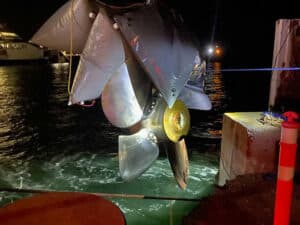
- September 10, 2024
- Ferries , News
Propeller drops off 60-year old BC Ferries Queen of New Westminster
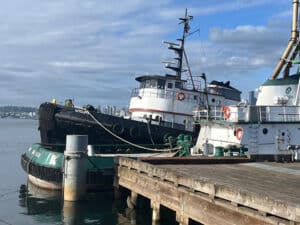
- September 09, 2024
- Coastal , Ferries , News
Tug crew abandoned as WSF cancels sale of two decommissioned ferries
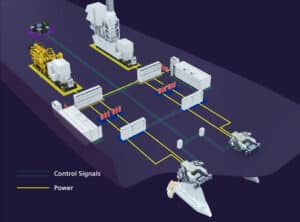
- September 04, 2024
Siemens Energy pioneering innovative solutions for marine decarbonization

- Ferries , News , Passenger
FERRIES 2024: Managing chaos as a small ferry operator
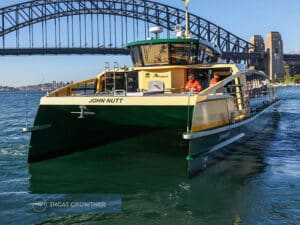
- August 30, 2024
VIDEO: Second Parramatta Class ferry enters service in Sydney
- Frank Magazine
- Denison History
- Virtual Tours
- Alaskan Yachts
- Azimut Yachts
- Back Cove Yachts
- Beneteau Yachts
- Benetti Superyachts
- Bertram Yachts
- Boston Whaler
- Broward Yachts
- Buddy Davis Sportfish
- Burger Yachts
- Cabo Yachts
- Carver Motoryachts
- Center Console
- Chris-Craft Yachts
- Cruisers Yachts
- DeFever Trawlers
- Dufour Sailboats
- Fairline Yachts
- Feadship Yachts
- Ferretti Yachts
- Formula Yachts
- Fountaine Pajot Cats
- Grady-White
- Grand Banks Trawlers
- Hargrave Yachts
- Hatteras Yachts
- Hinckley Picnic Boats
- Horizon Yachts
- Hydra-Sports
- Intrepid Boats
- Jarrett Bay Sportfish
- Jeanneau Yachts
- Kadey-Krogen Trawlers
- Lazzara Yachts
- Luhrs Sportfish
- Marlow Yachts
- Maritimo Yachts
- Marquis Yachts
- McKinna Motoryachts
- Meridian Yachts
- Midnight Express
- Mochi Craft
- Neptunus Motoryachts
- Nordhavn Trawlers
- Nordic Tugs
- Ocean Alexander Yachts
- Offshore Yachts
- Oyster Sailing Yachts
- Pacific Mariner Yachts
- Palmer Johnson Yachts
- Pershing Yachts
- Prestige Yachts
- Princess Yachts
- Pursuit Yachts
- Riva Yachts
- Riviera Yachts
- Sabre Downeast
- San Lorenzo Yachts
- Sea Ray Boats
- SeaVee Central Consoles
- Selene Trawlers
- Scout Yachts
- Sunseeker Yachts
- Tiara Yachts
- Trinity Superyachts
- Viking Yachts
- Westport Yachts
54 Irwin 1990 Boat For Sale
Asking price: $375,000.
- Yachts for sale
- 54' Irwin
Last updated Feb 13, 2024
54' Irwin 1990
A Rare GemRefreshing to find a boat that is lavishly maintainedand constantly upgraded
VIEW THE 360 DEGREE VIRTUAL TOURThe Irwin 54 is one of the most popular sailing yachts over 50' ever built. Find out why
For over 20 Years, the current owner had an open check book tocontinually upgrade and lovingly care for this amazing yacht
Over 250 Irwin 52’s and 54’s were built. First introduced in 1976, The Irwin 52 quickly became the most popular cruising center cockpit sailboat on the market. In 1988, the boat evolved into the Irwin 54 with a major redesign of the hull, deck and interior. “Patience“ is one of the last Irwin 54’s and possibly the best ever built.
“Patience” was ordered new by her original owner in 1989 and commissioned in 1990. The concept was to utilize the basic clever design and create a vessel of not just outstanding beauty, but also a yacht that is flawlessly executed and engineered to a standard normally seen only in larger vessels. The spectacular result is not only a "go anywhere" yacht, but also one of absolute luxury, total privacy and short-handed style.
The second owner purchased "Patience" for a two year Caribbean cruise and then sold her to the current owner.Current owner has owned this boat for the past 20 years!
Denison Yachting is pleased to assist you in the purchase of this vessel. This boat is centrally listed by Preferred Yachts.
Denison Yacht Sales offers the details of this yacht in good faith but can’t guarantee the accuracy of this information nor warrant the condition of this boat for sale. This yacht for sale is offered subject to prior sale, price change, or withdrawal from that yacht market without notice. She is offered as a convenience by this yacht broker to its clients and is not intended to convey direct representation of a specific yacht for sale.
INQUIRE ABOUT 54' IRWIN
Have questions about this yacht? Fill out the form below and our team of experts will contact you soon.
Your privacy is important to us. Find out how we protect it. Privacy Policy

First-Time Buyer?
Read our guide to learn the process for buying this 54' Irwin
54' Irwin HIGHLIGHTS
- Yacht Details: 54' Irwin 1990
- Location: Saint Petersburg, FL
- Engines: Yanmar
- Last Updated: Feb 13, 2024
- Asking Price: $375,000
- Max Draft: 12' 6''
54' Irwin additional information
- Beam: 15' 4''
- Hull Material: Fiberglass
- Displacement: 46,000 lb
- Fuel Tank: 1 x 340|gallon
- Fresh Water: 1 x 480|gallon
- Single Berths: 8
A Rare Gem Refreshing to find a boat that is lavishly maintained and constantly upgraded
VIEW THE 360 DEGREE VIRTUAL TOUR The Irwin 54 is one of the most popular sailing yachts over 50' ever built. Find out why
For over 20 Years, the current owner had an open check book to continually upgrade and lovingly care for this amazing yacht
Over 250 Irwin 52’s and 54’s were built. First introduced in 1976, The Irwin 52 quickly became the most popular cruising center cockpit sailboat on the market. In 1988, the boat evolved into the Irwin 54 with a major redesign of the hull, deck and interior. “Patience“ is one of the last Irwin 54’s and possibly the best ever built.
“Patience” was ordered new by her original owner in 1989 and commissioned in 1990. The concept was to utilize the basic clever design and create a vessel of not just outstanding beauty, but also a yacht that is flawlessly executed and engineered to a standard normally seen only in larger vessels. The spectacular result is not only a "go anywhere" yacht, but also one of absolute luxury, total privacy and short-handed style.
The second owner purchased "Patience" for a two year Caribbean cruise and then sold her to the current owner. Current owner has owned this boat for the past 20 years!
Interior Description
“Patience” sleeps six persons in three private cabins, excluding the main salon, with optional sleeping space in workroom.
She has a stunning interior that really has to be seen to be fully appreciated. (See the 3D Virtual Tour) She was designed and then customized around luxury, quality and functional elegance. The interior is truly gorgeous and maintained in show condition at all times.
Starting forward is VIP Stateroom with centerline queen berth.
Next aft to starboard is the Guest Cabin with a double berth.
The Guest Head is to port and features a separate shower stall and a separate door to the Vip Stateroom and another door that opens into the hallway.
The huge raised Main Salon features large fixed ports, offering a panoramic view outside. To starboard is another “L” shaped settee and dining table. Next aft is a desk and breakfast bar.To port is a “L” shaped settee followed by a large Chart Table. Here is located the electronic switches for AC and DC Systems. A large flatscreen TV is located above and navigation instuments are outboard. An eight bottle wine cooler is located below.
Next aft and down two steps is the Galley. The galley on “Patience” will appeal to any cruising gourmet and is equivalent in size to what you'd expect on boats much larger. The galley provides ample counter space, cabinets and drawers for storage. Opposite the galley is the separate laundry room and complete walk-in workshop.
- Full size upright refrigerator with separate top loading freezer (Grunert 120 volt with holding plates)
- Force 10 3-burner stove with oven (gimbaled)
- Toaster Oven
- G.E. full size microwave
- Built in automatic coffee maker
- Built in Ice Maker
- “Blanco” sink with trash chute and cutting board
- PG safety solenoid valves with leak detector
Across from the galley is the Workshop and Laundry Room. The work bench has cushions to create another berth. The captain and crew are kept in clean clothes by using the full size Miele, 220V, high quality washer and dryer.
The Owner's Stateroom features a centerline queen berth, large hanging locker and numerous drawers and cabinets.
The en-suite Owner's Head has a separate stall shower/tub.
At Chart Table
- Garmin GPS with color chart plotter, anemometer and sonar
- Built-in ICOM SSB radio
- Built-in Simrad VF radio with wireless remote
- Four Midland handheld radios
- Garmin GPSmap XSV chartplotter with radar and sonar
- RaymarineWindspeed and Direction
- Raymarine Depth Sounder
- Raymarine Multifunction Display
- Raymarine Autopilot
- Garmin Multifunction Display
- Fusion Radio Control
- Garmin Radar with mast mounted closed array antenna
- Raymarine Steering Pedestal Mounted anemometer
- Raymarine Steering Pedestal Mounted Repeater
- TCI TV and Sony DVD in Main Salon
- Samsung TV in forward VIP stateroom, LG DVD player
- Polariod TV and LG DVD in forward guest room
- Haier 120 VDC Wine Cooler
- Fusion stereo Main Salon
- Fusion stereo in Cockpit
- Samsung TV and Insignia DVD in aft stateroom
- Omnidirectional and Satellite TV antennas
- Engine: Yanmar 4HL-HTE 140 hp turbo diesel engine was rebult in 2017 and shows about 670 Hours
- Generator : Phaser K4-15 KW Generator was replaced
- Spectra Water maker
- Vetus 24 Volt DC Thruster
- Windlass Lighthouse 24 Volt DC
- Dinghy Davit TNT 24 Volt DC
- 120 VAC Miele clothes washer/dryer combination
12 Volt System
- (2) 31 AGM starting batteries for engine and generator
- (2) 4D house batteries
24 Volt System
- Group T105 like 6 Volt batteries connected in series
Promariner Pronautic 1260P 12VDC/60 AMP marine grade battery charger digital display in chart table area
50 Amp Shore Power cord
- Promariner Pronautic 1260P 12 Volt Marine Battery Charger
- 24 Volt Marine Battery Charger
- Promariner Promar digital display at the chart table
- Spectra Cape Horn 12 Volt DC Watermaker
- Water Heater 20 Gallon
The current owner decided to remove the Hood Stoway mast and upgrade the mast and rigging to a custom Seldon mast with a hydraulic furling system around 2010. He has an impressive above deck rig that rivals vessels of a much larger size and higher price range. A lot of thought by the experienced owner went into making “Patience” easy to sail by a couple and enhance the performance.
- Hydraulic main sail
- Hydraulic roller furling on Genoa
- Roller furling on staysail
- Running rigging for staysail
- Navtec hydraulic adjuster
- Whisker Pole
- (2) #36 Barient 24V electric primary winches (with controls at winch and helm)
- #27 Barient hydraulic main sheet (with controls at winch and helm)
- (2) #21 Barient self tailing halyard winches
Schedule a Tour of 54' IRWIN
Contact our team to schedule a private showing.
SIMILAR YACHTS FOR SALE View All
64' custom 1971, miami, fl, us, 64' queenship 1999, san diego, ca, us, 64' burger 1965, redondo beach, ca, us, 64' riviera 2004, lady caradoc, 64' horizon 1999, stuart, fl, us, 64' cnb 2001, agde, 34, france, other irwin yachts for sale view all, merritt island, fl, us, 52' irwin 1979, oriental, nc, us, 52' irwin 1986, stevensville, md, us, 68' irwin 1990, la conner, wa, us, 52' irwin 1987, annapolis, md, us, 52' irwin 1989, beaufort, nc, us, price watch.
Love this yacht? Get notified on price reductions and other related updates.
Our Newsletter
Stay informed on all things yachting, including notable sales, industry updates, events, and boating tips with our newsletters.
sailboats News
Read the latest sailboats news and stay up to date on related events.
RELATED SERVICES

LOGIN OR REGISTER
Hi, welcome back.
Login and pick up from where you left off.
Creating an account allows you to save and compare your favorite yachts.
By creating an account you agree to the terms of use and our privacy policy.
A-1 Electric
Photos & videos.
See all 1 photos

Services Offered
Verified by Business
Generator Repair in 1 review
Appliance Repair
Electrical Panel Installation
A/C Installation
Appliance Installation
Commercial Services
Electrical Panel Repair
Other Electricians Nearby

Red Royal Electric
in Electricians
It’s Electric

Rutledge Electrical Design
About the Business
Business owner information
Forrest Maynard L.
Business Owner
A-1 Electric is serving the St. Petersburg and surrounding areas, as has been since 1971. A-1 Electric is a family owned and operated, electrical firm, proudly serving residential and commercial customers. A-1 Electric offers 24 hour emergency services to our valued customers. …
Location & Hours
Suggest an edit
4823 46th Ave N
Saint Petersburg, FL 33714
Serving Saint Petersburg Area
| Closed now | |
Amenities and More
Ask the community.
Ask a question
Yelp users haven’t asked any questions yet about A-1 Electric .
People also searched for
Whirlpool Appliance Repair
Lg Appliance Repair
Generator Repair
Electrical Repair
Commercial Electricians
Dry Rot Repair
Recommended Reviews
- 1 star rating Not good
- 2 star rating Could’ve been better
- 3 star rating OK
- 4 star rating Good
- 5 star rating Great
Select your rating
Overall rating

The guys that came to my house from this company were amazing. They completed a job that no one else could do. My general contractor struggled and struggled snd finally gave up but these guys did it with no problem or complaint. I highly recommend them.

We had some outdoor electrical outlet and light pole connection that was were the wires were rotted by weather & water exposure and thus shorted, and A1 Electric came through and charged less th and half of what a larger competitor wanted to charge. We will be going with A-1 from here out.
DO NOT USE THIS COMPANY. I cannot caution you enough. They were contacted by a realtor to do an estimate on a property I was purchasing. I reached out to them to do the work. When the property did not close on time, I cancelled the work. No contract was signed. They went in and did the work, without permission. I don't know how they got in. They are now trying to hold me responsible for payment. I did not own the property at the time the work was done. They are threatening to file a judgment against the property. I offered to settle, they owner of the company would not even speak to me in a civilized manner. He even hung up on me. I CANNOT SAY LOUD ENOUGH...DO NOT USE THIS COMPANY
A-1, unfortunately not in my opinion. Called to get a few electrical repairs b-4 realtor walk thru n the company cancelled on me twice. Once b/c of a Spring storm then a few days later b/c they were "down" 1 tech. Really A-1. Obviously the company is small operation. Pinellas County Electric came thru for me after A-1 left me high n dry twice.
Jan 22, 2018
Yolanda, Thank you for your feedback. We sincerely apologize our company did not meet or exceed your expectations, as this is always what A-1 Electric strives for. We are grateful however, that Pinellas County Electric was able to assist you with your electrical needs to ensure your realtor walk thru was a success. We thank you for having considered A-1 Electric and we hope you would consider giving us another chance, should you come to need any further electrical repairs. A-1 Electric
I'll definitively use them again! I needed to have some electrical work done but didn't know who to call. I was referred to A-1 from a friend. They were on time and very friendly. They did a great job in a timely manner and I was very satisfied with the cost.
Greg, First, we thank you for taking the time to write us a review! Your feedback means so much to us and is greatly appreciated. Furthermore, we thank your friend for referring you to our company and we are extremely grateful for your support and business. A-1 Electric
2 other reviews that are not currently recommended
You Might Also Consider

Master Restoration
in Damage Restoration

Time On Target Security
in Security Systems, Home Network Installation, Home Automation
Browse Nearby
Things to Do
Restaurants
Lamp Stores
Chandelier Store
Find more Electricians near A-1 Electric
Service Offerings in Saint Petersburg
Home Theater Installation
Smoke Detector Installation
Solar Panel Repair
Wiring Installation
Related Cost Guides
Building Supplies
Decks & Railing
Electricians
Insulation Installation
Window Washing
People Also Viewed

Coastal Palms Electrical

Driven Power Systems

Simpson Electric

Izzo Electric

Maynard Electric

Cox Air Conditioning & Heating

Sunrise Electric

Red Cap Plumbing, Air & Electric

Groves Electric

IMAGES
VIDEO
COMMENTS
Arcona Yachts are ultimate for both cruising comfort & sailing performance in the 34-46 feet range. Arcona - take your family sailing one weekend and you win races the next. Change language. ... Yet another new launch - this time an Arcona 435 Mk II with electric propulsion. ⚡️ ...
Sweden's Arcona Yachts has announced that their new Arcona 415 has Oceanvolt electric propulsion as a standard feature, a first for series-produced sailing yachts. Having electric as standard on a boat like the 415 marks a big change. Now it means that potential owners would have to specifically ask about diesel as an option, which then ...
The Arcona 415 can also be upgraded to an Oceanvolt Servoprop 15kW electric propulsion system, with variable pitch propeller technology and comes with a 23.2kWh* battery pack. A 15kW electric motor is the equivalent of a 50hp diesel engine on our 40-43ft yachts.
The new Arcona 415 is pitched as the first series-produced yacht with electric propulsion as standard. Arcona already has a long history of developing boats with optional electric motors, dating ...
Imported into the US market by Green Marine, the Swedish-built Arcona 435Z is a rarity: an all-electric cruising sailboat. Jon Whittle. This past October, I saw one of the most interesting exhibits in more than 500 new cruising sailboats I've reviewed over two decades. It was the Arcona 435Z, built in Sweden and introduced by Graham Balch of Green Yachts in San Francisco.
In terms of power, the Arcona 415 is equipped with an Oceanvolt Servoprop 15kW electric propulsion system, with variable pitch propeller technology. It has a 19kWh battery pack as standard. A 15kW electric motor is the equivalent of a 50hp diesel engine on our 40-43ft yachts. For the propulsion system, Arcona works with Oceanvolt.
The new features on the Arcona 415, and the electric propulsion as a standard have been introduced to ensure that the Arcona 415 remains at the forefront of modern performance cruisers on the market today.". For further details on the Arcona 415, please contact [email protected] or call +46 8 519 410 40. PRESS RELEASE - SWEDISH.
Electric propulsion is gradually becoming more and more mainstream for sailing yachts, and it makes sense. Electric yachts are virtually silent, maintenance free, have zero emissions and are ready at the touch of a button. Arcona claims its new Arcona 415 is the first production yacht to come with electric propulsion as standard, and is designed into the boat from the very start.
The new features on the Arcona 415, and the electric propulsion as a standard have been introduced to ensure that the Arcona 415 remains at the forefront of modern performance cruisers on the market today.". For further details on the Arcona 415, please contact [email protected], visit arconayachts.se or call +46 8 519 410 40.
Arcona Yachts of Sweden has launched its latest model, the Arcona 415, which the company claims is the first series-produced sailing yacht with electric propulsion as standard. The company launched its first zero-emission vessel, the Arcona 380Z, in 2015, and electric propulsion is available across the Arcona fleet as an upgrade option.
The company's goal is to make sustainable yachts truly serial. The new Arcona 415 is marketed as the first production yacht with an electric propulsion system as standard. Arcona's previous experience. Arcona has extensive experience in the development of boats with additional electric motors. It all started with the 380Z, which was launched in ...
New Arcona 415 first sailing yacht with electric propulsion standard - Plugboats. Sweden's Arcona Yachts has announced that their new Arcona 415 has Oceanvolt electric propulsion as a standard feature, a first for series-produced sailing yachts.
The Arcona 415 is one of the first series produced sailing yachts with electric propulsion as standard. Electric propulsion is already available across all the Arcona fleet as an upgrade option and Arcona Yachts is proud to have the largest fleet of electric 'zero emissions' yachts on the water, the first being the Arcona 380Z launched in 2015.
In terms of power, the Arcona 415 is equipped with an Oceanvolt ServoProp 15kW electric propulsion system, with variable pitch propeller technology. It has a 19kWh battery pack as standard. A 15kW electric motor is the equivalent of a 50hp diesel engine on our 40-43ft yachts. For the propulsion system we are proud to work with Oceanvolt, who ...
The Arcona 380Z is a standard production yacht that has been adapted for electric propulsion. Note the increased solar panel surface area with soft panels bonded to the sails. Credit: Jukka Pakainen. A modern electric yacht can come in all shapes and sizes, from the latest high-tech speed boats with recently developed high-performance electric ...
Arcona Yachts; Arcona Yachts Electric boats for sale. Save Search. Clear Filter Make / Model: All Arcona Fuel: Electric. Location. By Radius. By Country. country-all. All Countries. Country-SE. Sweden. Country-US. United States. All. Tout 25 km 50 km 100 km 200 km 300 km 500 km 1000 km 2000 km 5000 km. from your location.
Arcona boats for sale on YachtWorld are listed for a range of prices from $134,900 on the moderate end of the spectrum, with costs up to $895,353 for the most luxurious yachts. What Arcona model is the best? Some of the most iconic Arcona models presently listed include: 465 Carbon, 410, 385, 370 and 400. Various Arcona models are currently ...
The Arcona 435Z is the beautiful and perfectly engineered yacht that exemplifies the Arcona brand, but now made 'green' with the Oceanvolt Electric Motor and full electric system. In the Arcona 435Z we have multiple electric systems that are helping make this stunning vessel the green yacht it is. The 15 kW 48V system is run from the usual ...
Today, Vessev publicly shared images and footage of its first completed VS-9 electric hydrofoil boat build. Our previous coverage of the vessel included photos of the boat tub only; the one ...
And lastly, if you are going to cross the Atlantic in an electric sailboat, it makes a huge difference to do it in a sailboat with three key characteristics: Performance - the Arcona 435Z averaged over 8 knots sailing across the ocean, which is fast for a monohull sailboat just over 40 feet. Whether it is a catamaran (that is stable and safe ...
The new Cosmopolitan 125 catamaran features a hybrid solar-electric propulsion system for zero-emission cruising and a huge beach club for fun at sea.
Azimut and Volvo Penta are unveiling the world's first yacht - the Seadeck 7 - to combine Volvo Penta IPS with hybrid-electric power.
According to VonMercier, the Lucerne Electric Jet Craft offers 150 horsepower (110 kW) and is powered by an advanced lithium-ion battery system that provides the right balance between weight and ...
In Kapellskär, the electric foiling Candela charged with a Kempower movable charger, a 40-kW wheeled charger connected to the existing power grid at the harbor. In Finland's Mariehamn, the boat was plugged into the marina's three-phase outlet. In the evening at 6 p.m., the electric boat pioneers flew back toward Sweden.
Saint Petersburg is the Arcona's headquarters. That's why we've been dragging out its digitization for a while. Knowing how popular all the central part...
Over 250 Irwin 52's and 54's were built. First introduced in 1976, The Irwin 52 quickly became the most popular cruising center cockpit sailboat on the market. In 1988, the boat evolved into the Irwin 54 with a major redesign of the hull, deck and interior. "Patience" is one of the last Irwin 54's and possibly the best ever built.
For Sale - 4986 62nd Ave S, Saint Petersburg, FL - $3,200,000. View details, map and photos of this single family property with 4 bedrooms and 5 total baths. MLS# TB8300527.
Specialties: A-1 Electric is serving the St. Petersburg and surrounding areas, as has been since 1971. A-1 Electric is a family owned and operated, electrical firm, proudly serving residential and commercial customers. A-1 Electric offers 24 hour emergency services to our valued customers. Established in 1967. A-1 Electric is serving the St. Petersburg and surrounding areas, as has been since ...